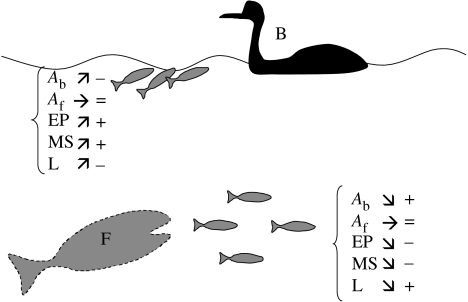Figure 5.
Trade-offs in predator–prey risks for fish that perform ASR in hypoxia. AB indicates the probability of attack by aerial predators (B), Af, the probability of attacks by fish predators (F); EP, escape performance; MS, metabolic scope and the probability of survival related to the physiological effects of hypoxia, L, the cost of locomotion. Signs ↗, ↘ and → indicate a relative increase, decrease or no potential differences, respectively, when comparing surfacing versus staying in the water column. Piscivorous fish are represented in grey and dotted contour since they may not represent a threat in hypoxia. The sign ‘+’ indicates an advantage; ‘−’, a disadvantage; and ‘=’, no difference in relation to the fitness of the fish. Surfacing allows fish to avoid the negative effect of hypoxia on their metabolic scope and to have a high escape performance. On the other hand, surfacing increases the probability of being detected by aerial predators and it implies a higher cost of locomotion due to vertical excursions.

